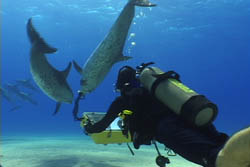
July 10. It’s been thirty 32 years since I first sailed into the world of the spotted dolphins who inhabit the northwestern Bahamas. This year we’re near Bimini, a location I first discovered in 1987 aboard Juliet, a 103-foot schooner with spacious, comfortable staterooms.
We left Miami at 4pm, passing through light rain. Giant black and gray cumulous hovered behind us over the highrises that face on government cut. Two massive cruise ships preceded us, the two carrying roughly three thousand passengers. Quite a contrast with Juliet carrying twelve plus crew of four.
At 2am July 11 we anchored north of Bimini and woke up to dolphins around the boat. There were approximately sixteen spotters, mostly juveniles.
My goal is to get as many identifications as possible of individuals here. Most of my work with dolphins in the Bahamas has been with the pods of the White Sand Ridge, north of Grand Bahama island. In 2004 and 2005 that area was hit by massive cat 5 hurricanes. Many of the dolphins previously identified in that area were not seen after those events. There is a possibility they moved to other areas and Bimini is not far from the northern schools.
It was even thought that Chopper, whom I first identified in 1979 and had known personally for nearly three decades, had been among the victims of the tempests. But Denise Herzing, a dedicated scientist who has studied the White Sand Ridge school, told me she had seen him in 2007. That was a relief.
The dolphins found us about 730 am. They were really engaged with the divers. I shot some nice video. After a midday break of diving and lunch we found dolphins at 4pm. They were playing wildly amongst themselves. They had no interest in us but they did not run from us. I found myself totally enveloped in dolphins during some of my freedives and the video came out nicely. So far we’ve only been able to identify one dolphin from this area – one with a shark bite that tore away half the dorsal fin.
July 12 we found dolphins early but disengaged when they seemed to want to be on their own. The weather is very hot – in the mid 90s and I’m urging everyone to drink water, take salt and keep slathered in sunscreen. Late afternoon we found dolphins feeding. Entered the water and a lone teenager came to a group of 8 of us passing very close to each diver, closing its eyes in a sign of trust. Maybe a smile. Gazed at itself in my camera dome.
July 13. Brilliant scuba dive on a drop off north of Bimini. In afternoon there were four boats looking for dolphins. Not a good scene. We had only minor contacts and I broke off in late afternoon. We will head for another location. It just didn’t feel good to me to see all those boats running around trying to pick up dolphins.
July 14. Dove Bull run. Friends very happy with the reef sharks. Ran to b-2 and found dolphins immediately. Two close encounters with them. One appeared to have been slapped with silver paint three times on right side. Another had deep cut in dorsal starting just forward of the peak. A lovely squall swept over Juliet just after dinner.
July 15. Seas came up over night. Three to four foot swells in the morning. Six playful young dolphins hit our bow after breakfast. One was silver paint. Divers had a phenomenal experience with this group for 45 minutes. Seas layed down.
July 16 Awoke in Miami harbor and said goodbye to the BlueVoice supporters who had accompanied us. Tomorrow a new group joins us and we head back to the Bahamas.





